The analysis of the gameplay of Fire Emblem Heroes was offered on the pages of his blog by Motoi Okamoto, who led the work on Wii Fit and Super Mario 64 DS. We share the translation of the material.

Motoi Okamoto
Fire Emblem Heroes was released on February 2 and has already managed to achieve serious success, especially in Japan and in the USA. This Nintendo project immediately took third place in the top of the highest–grossing Japanese games on iOS and eighth place in the American box office top. On the first day, the game earned $2.9 million and from that moment remained in the top three most popular games in Japan, along with Monster Strike from mixi and Fate / Grand Order from Sony.
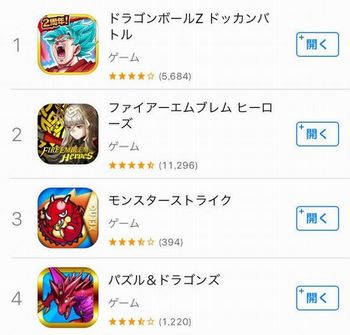
Fire Emblem Heroes took second place in the box office top on iOS
The game owes its success in Japan, among other things, to the correct release time. Local publishers strive to earn as much as possible during the New Year holidays on events and gacha. As a result, by the beginning of February, players are “tired” and sales are falling. Therefore, when FEH came out, the audience of hardcore mobile RPGs gladly switched to this project.
Users of Fate / Grand Order, Final Fantasy Record Keeper, Colopul Rune Story, Granblue Fantasy, Shadowverse almost simultaneously started playing FEH. And, of course, Nintendo fans didn’t stay away either (Fire Emblem is a cult Japanese series of turn–based tactical role-playing games. The publisher of the series is Nintendo, – approx. editorial offices).
And now let’s analyze the monetization and game design of the game.
Gameplay and fan reaction
Fire Emblem Heroes is a “simplified” tactical RPG. Battles take place between squads of 4 units (later the number of enemies grows). In traditional tactical RPGs, you first need to approach the opponents, and then choose one specific one of them to make an attack, and in this game you just move the unit icon to the enemy, after which the character immediately performs both movement and attack.
The visualization of the action is very short. However, many popular characters of the series appear there.
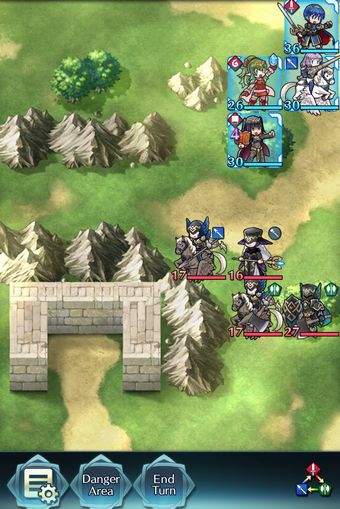
An uncomplicated battlefield in Fire Emblem Heroes
Judging by the reviews, the game disappointed many fans of the franchise. The mobile version turned out to be much simpler than the console version. The quality also caused complaints: the tutorial was considered too simple, the UI was sloppy, the plot was short, the description of the characters was incomplete, the action was boring, and so on.
On the other hand, the good thing about the mobile version is that it can be played in short sessions. The number of units was reduced, and the map was reduced, and it turned out that the battle lasts not 30 minutes, but 3.
And, of course, the player was given the opportunity to collect and upgrade popular characters in the series.
Monetization and gacha analysis
At the beginning of the game, the user has four characters. To summon additional heroes, you need spheres (orbs). They are bought for real money or are rewarded for completing the next segment of the map. This is the so-called gacha.
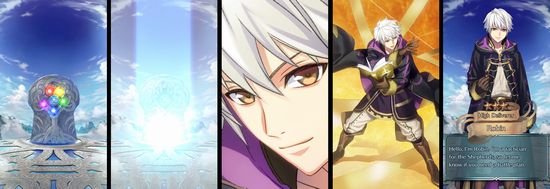
Getting a hero in gacha is accompanied by beautiful animation
Nintendo and DeNA have added several features to the standard gacha:
- before the gacha starts, you need to choose one of the five colored spheres in the magic circle;
- the probability of the appearance of “five-star” units increases with each new attempt;
- the cost of gacha drops with each attempt ( 5 spheres/4/4/4/3).
This means that it is most profitable to buy 20 spheres and run gacha five times.
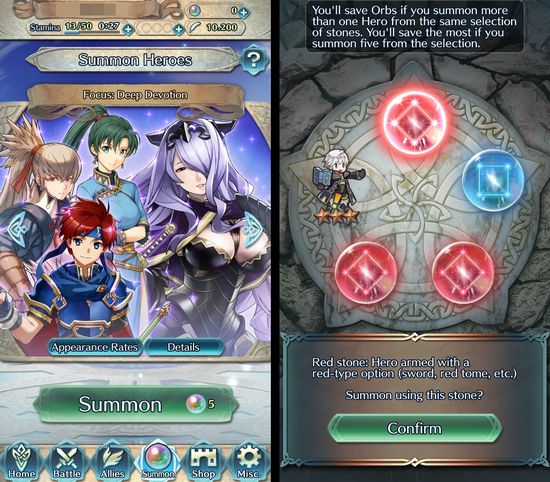
Choose one of the five spheres in the magic circle and start the gacha
If you look at the statistics of in–game purchases, then in second place is a set of 23 spheres. That is, such a monetization strategy is a success.

Sphere sales statistics in iTunes
I will add, according to my observations, paying FEH users are divided into two types.
The first type of gacha is familiar from other RPGs, and he is ready to overpay for it.
The second type is more economical players. They consider it more profitable to buy five gacha launches at a time. I’ll assume that the latter are Nintendo fans who have never had to pay for gacha before.
The fight and the “pressure of growth”
Unlike other games in the series, there is no evasion option in the FEH action game. There are no elements that depend on luck, respectively, it is easier to predict the outcome of the battle and the battles are more like a chess match. The speed option (Spd in the image) has nothing to do with evasion. If your unit’s speed is higher than five or just higher than the enemy’s, then the unit attacks twice in one turn.

- Atk: Physical attack power
- Spd: If the unit’s speed is higher than 5 or higher than the opponent’s, the unit attacks twice per turn
- Def: the level of protection against the physical attack of the enemy
- Res: Resistance level to magic attack
As in other games in the franchise, it is not difficult to calculate the damage from an attack in FEH. To do this, you need to subtract the unit’s defense level (Def) from the opponent’s physical attack strength (Atk). To calculate the damage from a magic attack, you need to subtract the resistance force (Res) of the unit from the opponent’s physical attack force (Atk).
In other words, if your character’s attack power is too low or the opponent’s defense level is too high, then the damage will be zero.
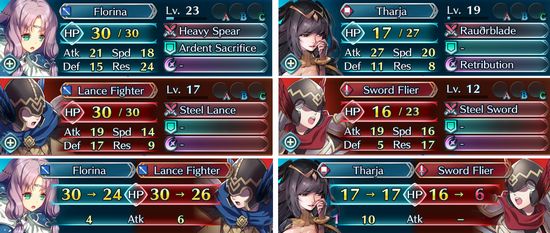
Floria’s attack is 21, the enemy’s defense is 17, that is, the damage will be 4 units (21 – 17). Tharja’s attack is 27, the enemy’s resistance is 17, so the damage will be 10 units (27 – 17))
Such formulas are typical for console RPGs. They allow developers to easily predict how the characters will be pumped. If the strength of the player’s units deviates even slightly from the predicted parameters, the complexity of the game will immediately increase.
For mobile RPGs, on the contrary, this formula is atypical: players get characters using gacha, which means that the parameters of units can vary. In mobile, it is usually considered as follows: damage = (100 – defense) * attack power.
As I have already mentioned, attack power, defense and resistance play a very important role in FEH combat. This means that compared to other RPGs in FEH, you need to pay more attention to leveling up your character. The player experiences a kind of pressure – “growth pressure”.
In addition, experience points (Exp) are distributed unevenly between the teams participating in the battle and are awarded only to attacking units. If the unit dies, it will not receive experience points for the battle at all. Plus, if a high-level hero attacks a unit with a lower level, then the exp will also be low. That is, there is no way to earn experience points quickly and safely. In the process of leveling a character, you have to constantly look for a compromise between risk and benefit.
There is another way to raise the level of the character. You need to collect the shards (shards). But for this you will have to spend a lot of time and spend a huge number of fights in the Training Tower. If you swing in this way, then the “growth pressure” will be very high.
Perhaps the developers simply followed the traditions of the series, but in the end it turned out that the player is constantly motivated to pump units.
Here it should also be noted that usually mobile gamers do not like complex combat systems. But fans of the franchise are no stranger.
“Growth pressure” leads to “gacha pressure”
Due to the “growth pressure”, it seems to players that very rare units with the highest characteristics are needed for success. And that’s why they want to launch gacha more and more often. Thus, “growth pressure” leads to “gacha pressure”.
Besides gachi, there are other ways to get a rare unit. You can “unlock the potential” (Unlock Potential) of a character, that is, increase the rating and improve the characteristics. To do this, you need heroic feathers (Hero Feathers) and badges (Badges) or large badges (Great Badges).

Unlock the potential to boost your character’s rating
That is, it is easy to do without gacha, you ask? No, it’s not that simple. Nintendo and DeNA have thought everything through properly.
To get the feathers, the player needs to defeat another user’s team in the Arena. The fewer losses among the units, the more feathers you will be able to earn. To get badges, you need to participate in battles in the Training Tower.

For the feathers – to the Arena, for the badges – to the Training Tower.
The whole process takes a lot of time. It will take a stronger team to accelerate. In other words, sooner or later the player will want to get a rare hero through gacha. Even if you really try to avoid this method, in the end you will still want to resort to it.
Conclusion and a few words about the overall strategy of Nintendo
Finally, a few words about Nintendo. The mobile games of this publisher – Miitomo, Super Mario Run, Fire Emblem Heroes – are united by a common strategy:
- the user experience in a mobile game is not much different from the experience in a console project;
- however, the differences between the mobile version and the console version are obvious;
- it is convenient to play with one hand, the games themselves are simple, the sessions are short.
Nintendo has no plans to sell consoles and still pays a lot of attention to the growth of sales of console projects.
A source: motoiokamoto.wordpress.com
Translated by Irina Smirnova
